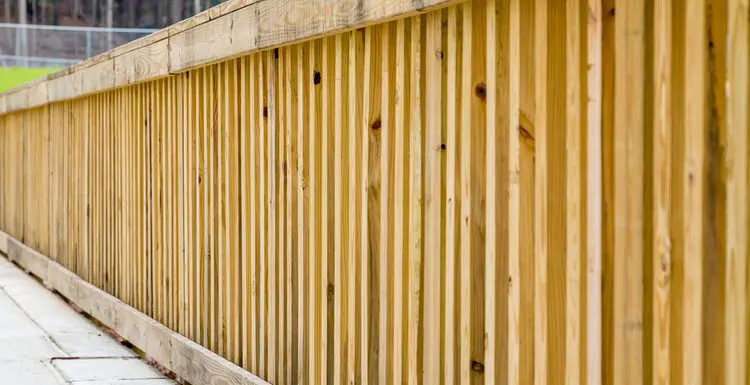Can you stain pressure-treated wood? Yes, you can. But there are a few things to consider.
For example, you need to prepare the surface and let the wood completely dry. We’ll show you everything you need to know below.
Can You Stain Pressure-Treated Wood?
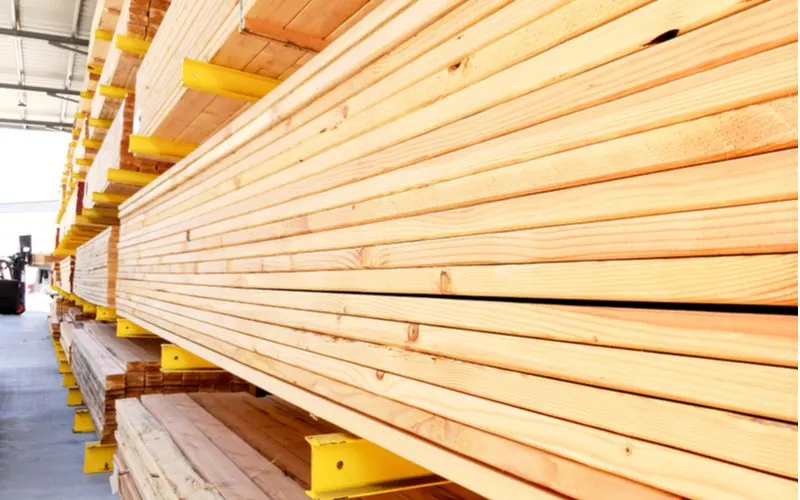
TonelsonProductions/Shutterstock
Staining pressure-treated wood involves the same steps as staining other types of wood:
- Clean the surface
- Allow the wood to dry
- Test the moisture level
- Choose the right type of stain
- Test the stain
- Apply one or more coats of stain
You’ll also need a few supplies, including:
- Stain
- Brushes
- Clean rags
- Water or pressure washer
Check the forecast before applying the stain. Most stains require at least 24 to 48 hours to fully dry, so try to choose a time with no rain in the forecast for several days.
How to Stain Pressure-Treated Wood in 6 Steps
1. Clean the Surface
Always prepare the surface you want to stain before starting. If you’re staining new wood, wipe the surface clean or spray it with a hose.
If you’re staining older wood, you may need to use a commercial wood cleaner or a pressure washer to remove tough stains and buildup.
2. Allow the Wood to Dry
After cleaning the surface, allow the wood to dry. Wood that’s still wet holds less of the stain. The stain absorbed by the wood also locks in moisture, which can increase the risk of warping, cracking, and wood rot.
Pressure-treated wood may take several weeks to several months to completely dry. Wood that is labeled as “wet-treated wood” may take longer to dry out.
We typically suggest letting the wood sit for about a year before staining. I did this with both my deck and my fence, and each project turned out great.
The pressure-treating process uses water at high pressure to force chemicals deep into the wood. The chemicals used to treat wood also increase the moisture content of the wood.
3. Test the Moisture Level
You can test the moisture level of the wood by sprinkling some water on the surface. If the wood absorbs the water within 10 minutes, it’s likely to dry enough to stain.
If the water beads on the surface of the wood instead of absorbing into the grain, the wood is likely too wet to apply a stain.
4. Choose the Right Type of Stain
Oil-based stains designed for exterior use are the best option for staining pressure-treated wood.
The wood absorbs oil-based stains completely, which increases its protection against water and mildew. Water-based stains dry too quickly to apply an even coat. Latex stains tend to hide the natural grain of the wood.
You can also find oil-based stains designed specifically for use on pressure-treated wood. Manufacturers formulate stains that can penetrate the wood more effectively.
5. Test the Stain
After choosing a stain, apply a test patch. Use a brush to apply the stain in a small, inconspicuous area and allow it to dry. If you’re happy with the results, you can continue staining.
6. Apply One or More Coats of Stain
Apply the first coat using long, even brushstrokes. Allow the first coat to dry before deciding whether you need a second coat.
You may also need to touch up a few spots, especially around corners and joints.
Tips for Applying Stain to Pressure-Treated Wood
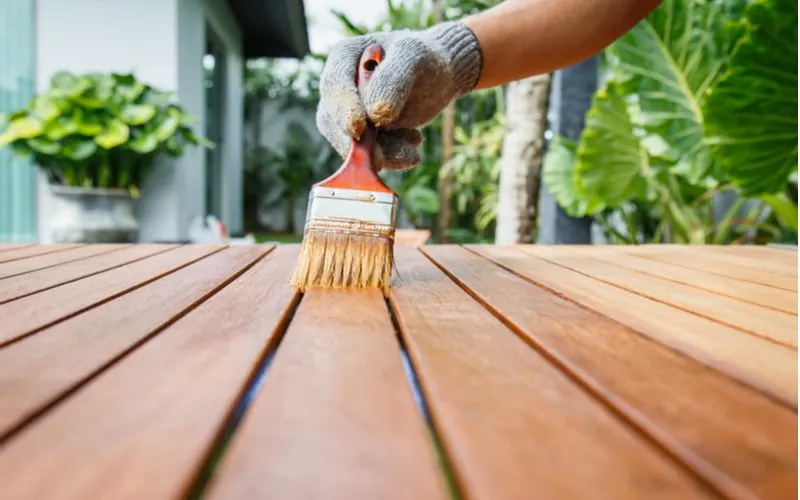
Piyawat Nandeenoparit/Shutterstock
Store pressure-treated wood indoors or cover outdoor structures to protect against rain. Pressure-treated wood may take weeks or several months to fully dry. Unless you live in a dry region, you may get rain before the wood dries.
If you store the wood indoors, bring it out when it’s time to stain. Be sure to apply the stain in a ventilated area. It’s also typically easier to stain after building.
For example, if you buy pressure-treated wood to build a deck, erect the deck before applying the stain. This keeps you from applying the stain to hidden areas, such as the underside. When staining fences and other vertical structures, start at the top.
Starting at the top allows you to even out the stain as it runs down the wood. Always stir the stain after opening the lid to ensure that it’s properly mixed. Some of the ingredients may start to settle during storage, making it more difficult to apply.
Can You Paint Pressure-Treated Wood?
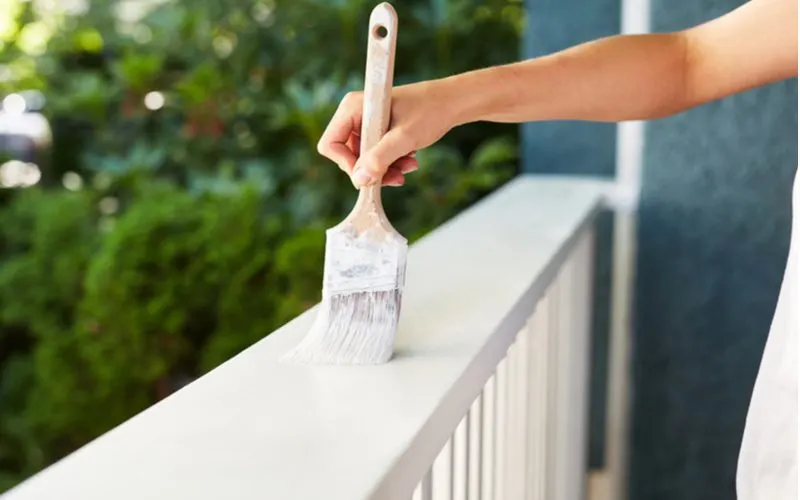
Michal Urbanek/Shutterstock
You can paint pressure-treated wood but you may need to take a few extra precautions for long-lasting results. Here are the steps involved in the process:
- Test the wood
- Clean the wood
- Apply a primer
- Apply at least two coats of paint
As with staining, you should not paint pressure-treated wood unless it’s completely dry. If you’ve recently purchased the wood, you may need to wait at least a few weeks or even several months.
Test the wood by dropping a few sprinkles of water on the surface. If the water beads, it’s too wet. If the water is absorbed, the wood is ready.
You also need to clean the wood before painting to remove any dirt and debris. Cleaning typically involves water, which means that you’ll need to wait another day or two before painting.
Instead of oil-based products, look for water-based paint. Water-based paints dry quickly, but it’s easier to apply an even coat of paint compared to applying a quick-drying stain. Water-based stains also maintain elasticity longer, which helps prevent cracking and peeling.
Purchase a primer and paint in the color of your choice. Applying primer helps bring out the color in the paint that you choose and limits the number of coats that you need to apply.
Even with primer, you’re likely going to need at least two coats of paint. The pressure-treated wood may not absorb the paint efficiently, which increases the required drying time and amount of paint needed.
Should You Use Acrylic or Latex Paint on Pressure Treated Wood?
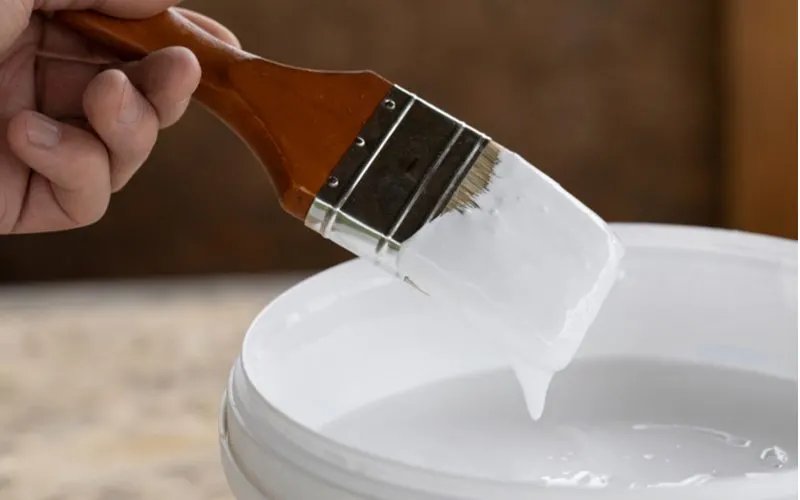
Olya Maximenko/Shutterstock
Acrylic paint is still considered water-based paint, even though it’s made with a chemical base. Acrylic paint contains more volatile organic chemicals (VOCs), which require better ventilation.
Acrylic paint is more flexible compared to latex paint, which is why it’s often used on canvas and other materials that stretch or move.
Wood that may expand and contract through the seasons may work better with acrylic paint. Acrylic paint is less likely to crack on wood furniture and decking that remains outdoors year-round.
If you want bright colors and a smooth paint finish, latex is your best option. Using latex paint requires fewer coats, as it offers greater coverage.
When you paint wood with acrylic paint, the wood grain is likely to show through until you add at least a few coats.
Latex paints are also available in a wider range of colors to suit your tastes. Most hardware stores and home improvement stores offer hundreds of existing colors and the option to blend colors.
Why Stain or Paint Pressure-Treated Wood?
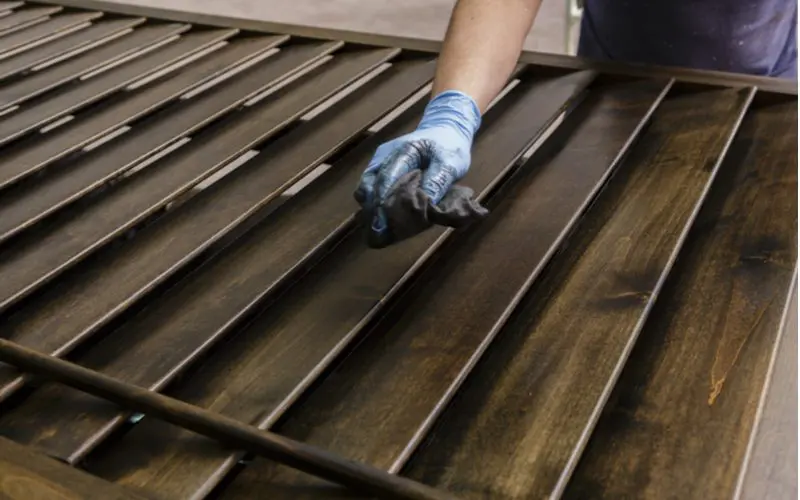
David Panazian/Shutterstock
Pressure-treated wood is treated to help prevent water penetration and protect against the elements. However, it can also look bland and unfinished without a stain or paint job.
Staining or painting the wood can enhance the appearance of decks, fences, and other wood structures.
You also add more protection against water and mildew. However, staining or painting pressure-treated wood requires planning.
So, Can You Stain Pressure-Treated Wood?
You can stain or paint pressure-treated wood. However, you should always wait for the wood to dry before staining or painting, no matter the type of wood.
Before staining or painting, remember to test the moisture content of the wood by sprinkling some water on the surface.

